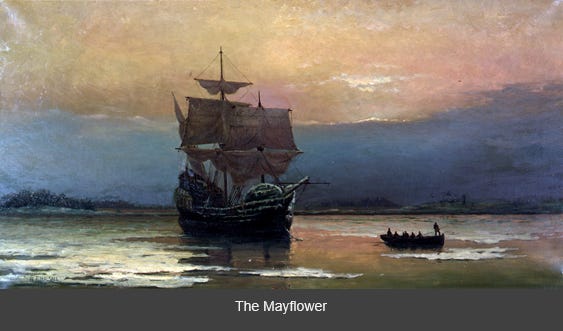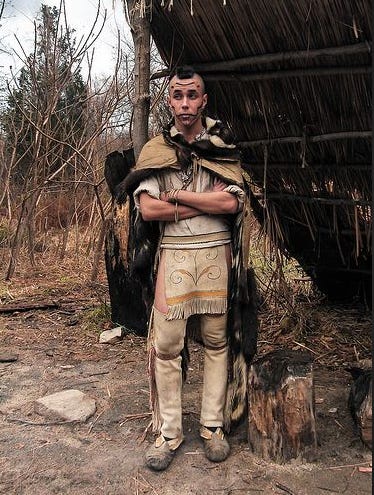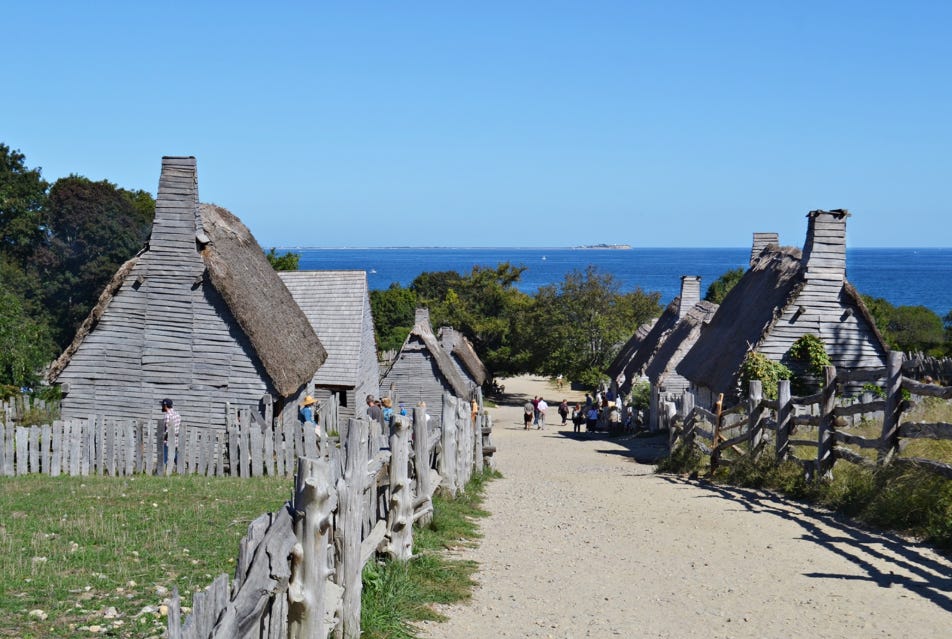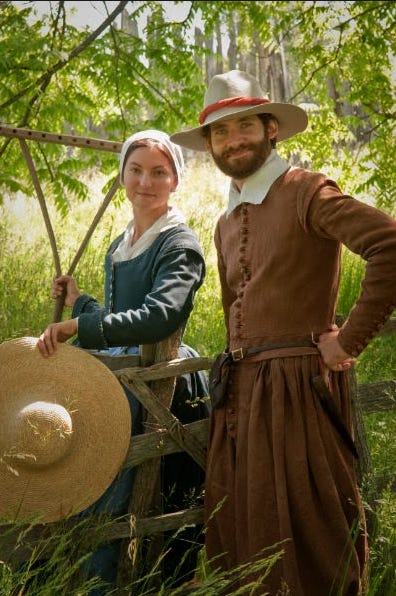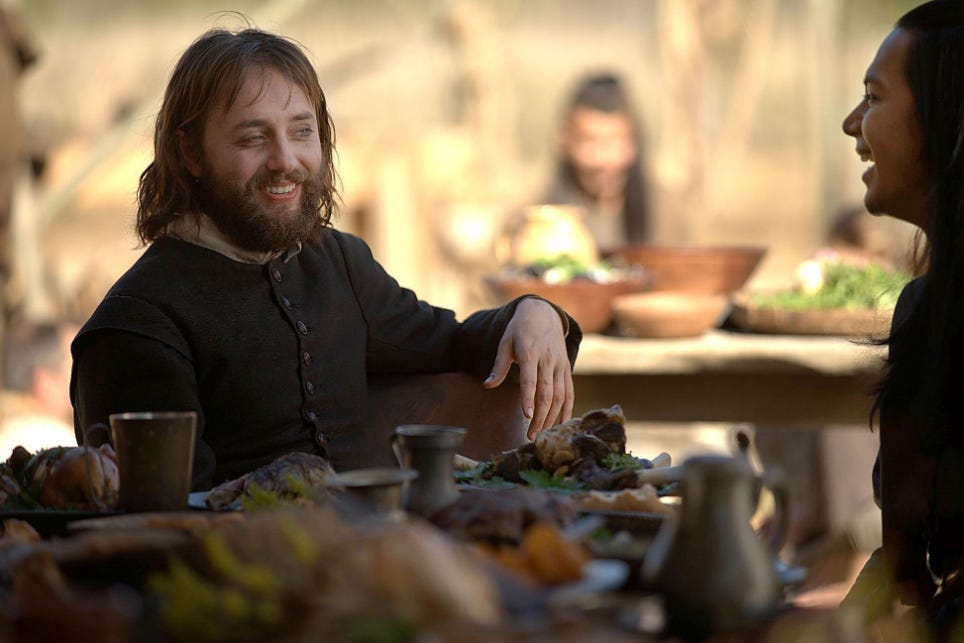A Three-Day Thanksgiving;
An Authentic 1621-Style Feast, Plimoth Patuxet style, by the New Plymouth Shore
Opening scene
Mist rising off a cold salt marsh; the roar of the Atlantic just beyond the dunes. Kettles hiss on a hearth, a drift of woodsmoke threads the air, and someone hauls a basket of mussels soaked clean in seawater. Fowl hangs from a hook. A great pot of maize porridge thickens slowly. Venison arrives—gifted by Wampanoag hunters. For three days, neighbors share what the land and water offer in season. TIME+1
Note on names and memory: No one in 1621 called this a “Thanksgiving dinner.” What we know comes mostly from a short eyewitness note by Edward Winslow and a passage by Governor William Bradford. The gathering lasted three days and included roughly 50 English and about 90 Wampanoag led by Ousamequin (Massasoit). The Wampanoag brought venison; the English contributed wild fowl—likely duck and goose—and they all had ready access to shellfish and fish along the shore. Plimoth Patuxet Museums+2HistArch+2
The coastline larder (what’s truly period-plausible)
Shellfish & fish: mussels, clams, oysters; lobster was abundant; eel common. Smoking and drying fish/shellfish is attested. Smithsonian Magazine
Wild game & fowl: venison (five deer mentioned), ducks, geese; turkey is possible but not certain from the sources. nationalgeographic.com
Field & garden: maize (corn) in porridges and breads, beans, squashes, pumpkins, native berries, nuts, wild greens, and herb simples from English kitchen plots (parsley, sage, thyme). Plimoth Patuxet Museums
What you won’t find (1621): wheat pies, potatoes, sugar-sweet cranberry sauce; cider/beer were unlikely in any quantity that year. Think broths, roasts, stews, and porridges—simple, seasonal, and smoky. Epicurious
This meal, featured below, is just one of the meals served at the museum restaurant. We not only loved this, but we were also seated with Squanto and all of him holiday garb and porcupine quills in his hair!
The 1621-inspired menu (with modern, doable methods)
Design this as a three-course procession you can serve in one evening—or stretch into a long afternoon with fireside grazing, nodding to the original three days.
1) From the Tidemark
Mussels “seeth’d” with parsley & ale (or broth)
Steam scrubbed mussels with a little water or light ale (or stock), handfuls of parsley, a slice of onion, and a splash of vinegar. Finish with a spoon of butter or oil and coarse salt. Serve with trenchers or toasted corn bread. (Plimoth historical dinners list a mussel dish very close to this.) Plimoth Patuxet Museums
Lobster at the fire
Split whole lobsters; brush with a simple basting of rendered fat or butter, parsley, and a dash of cider vinegar. Grill over hardwood coals until opaque and lightly charred. Historically, lobster was boiled, roasted, or pit-baked along the coast—simple and plentiful. Smithsonian Magazine
Smoked fish tidbits
Use local bluefish, mackerel, or salmon. Lightly salt, then warm-smoke until just flaky. Serve with pickled wild onions or vinegar-dressed greens.
2) The Hunt & the Garden
Roast wildfowl with herb basting
Duck or goose, spit- or oven-roasted, basted with sage, thyme, and a little vinegar. No bread-stuffing needed; present with pan juices. Wildfowl is explicitly mentioned in the sources. HistArch
Venison haunch or stew
If roast venison isn’t available, do a slow stew with onions, mushrooms, a splash of ale or broth, bay, and pepper. Venison is the one item we know was brought—by the Wampanoag, in quantity. nationalgeographic.com
Nasaump (Wampanoag corn porridge)
A thick porridge of coarse cornmeal simmered with water, nuts, and berries; serve savory (with a pinch of salt and herbs) beside the meats. Plimoth Patuxet Museums
Sallet of herbs & bitter greens
Watercress, parsley, tender kale leaves, and chopped egg, dressed with vinegar and a little oil or bacon drippings—mirroring 17th-century “sallets.” Plimoth’s historic dinners feature a similar sallet. Plimoth Patuxet Museums
Stewed pumpkin & squash
Cubed pumpkin/squash simmered gently with a little water, a sprig of rosemary or sage, and a knob of butter or oil until soft and spoonable.
3) Hearth-Side Comforts
Roasted nuts & dried berries
A simple board of walnuts, hazelnuts, dried blueberries/cranberries.
Cheese & coarse bread
If you want to stay close to 1621 scarcity, offer only a small board; otherwise, this is your “hospitality” flourish.
Warm “posset-style” milk (modern nod)
Warm milk or almond milk with a thread of molasses (period-adjacent) and grated nutmeg. (Strictly speaking, 1621 sugar/molasses would have been scarce; offer this as an after-piece, not a claim to the original table.) Epicurious
The three-day rhythm (how to host like 1621)
Day 1 – Gathering & Fowl: Receive guests, roast wildfowl, and set out mussels/lobster as the shore’s welcome.
Day 2 – Stews & Stories: Venison stew, nasaump, stewed pumpkin; children bring in driftwood, elders share lore.
Day 3 – Thanks & Games: Friendly contests and music; finish leftovers; send guests with portions.
Winslow’s brief letter hints at target practice/races and an open-air feel more than a single sit-down supper. Use long tables or blankets near a fire pit to echo that mood. TIME
Herb simples & worts (your brand touch)
Work small herbal touches that colonists and the Wampanoag would recognize:
Parsley, sage, thyme for basting and broths.
Wild mint in cool water.
Yarrow, rosemary sprigs to scent the fire and platters.
Service & setting (the look makes the memory)
Vessels: wooden trenchers, pewter-look chargers, iron or clay pots.
Textiles: natural linen, wool throws for outdoor seating.
Light & sound: a lantern cluster as your “lighthouse” and a single shell-trumpet or conch as a gentle “fog-horn” to gather guests for each course.
What the sources actually say
Two core sources shape our understanding:
Edward Winslow’s 1621 letter in Mourt’s Relation (1622). Plimoth Patuxet Museums+1
William Bradford’s Of Plymouth Plantation. Both point to a three-day celebration with wildfowl, venison, and local foods. TIME
Sensitive history, modern respect
For many Native people, the holiday carries grief. Acknowledge that truth in your introduction or closing note, and—if you wish—signal support for local Indigenous groups.
Credits & permissions
“Period images courtesy of Plimoth Patuxet Museums (Plimouth Patuxet).
Quick shopping & prep list (printable)
Mussels (or clams), live • Whole lobster • Duck or goose • Venison roast or stew meat
Coarse cornmeal • Winter squash/pumpkin • Wild/field greens • Parsley, sage, thyme • Onions
Vinegar • Butter or good oil • Nuts & dried berries
The closing toast
May your table be local, your fire bright, and your stories generous—
from shoreline mussels to venison stew, from maize porridge to roasted squash—
in the spirit of a shared three-day harvest on this coast we all call home.
— Phil Wilson & the Simples & Worts crew




